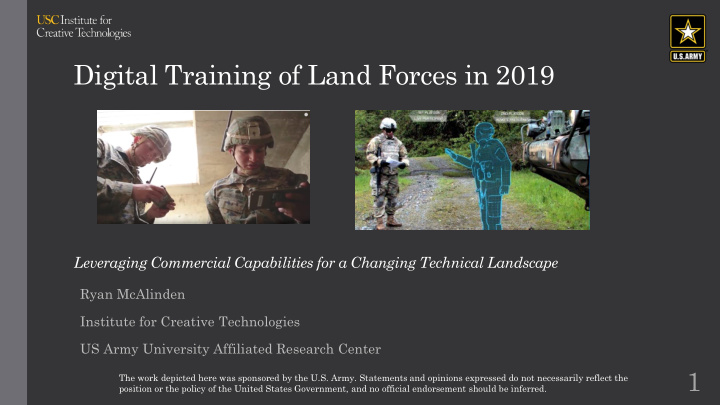



Digital Training of Land Forces in 2019 Leveraging Commercial Capabilities for a Changing Technical Landscape Ryan McAlinden Institute for Creative Technologies US Army University Affiliated Research Center 1 The work depicted here was sponsored by the U.S. Army. Statements and opinions expressed do not necessarily reflect the position or the policy of the United States Government, and no official endorsement should be inferred.
Overview • How technology is changing, and how the US DoD has tried to keep up • The short life-spans of technology today • The acquisition model associated with technology • Institutionalizing technological change within the Force Generational comfort • US Army’s Synthetic Training Environment (STE) • Working with the Commercial Sector 2
Technology Development: 1995 – Present • Modern technology platforms <1995: Software primarily built by small teams 1995 – 2015: Too expensive/risky, so big companies sprung up offering technology. Teams and budgets grew exponentially (>100 people; $10sM+) >2015: shift back to smaller teams Resulting from cheaper access to development tools • US DoD’s use of technology for training: Traditional Constructive simulations: OneSAF, JSAF Virtual training: VBS, CCTT Mission Command systems Instrumented systems Non-Traditional: First-person shooters America’s Army Call of Duty 3
Use of Modeling & Simulation to Train Land Forces Investment • Traditional kinetic: Offense, Defense 50% • Non-kinetic: stability, peacekeeping, 5% disaster relief • Collective training tasks 10% • Combined arms training tasks 5% Multi-domain battle Full-spectrum operations • Analysis, Experimentation, Testing 20% • Situational Awareness, mission planning, 10% rehearsal 4
US Army Synthetic Training Environment (STE) • What is it? STE is a collective, multi-echelon training and mission rehearsal capability It brings together the virtual, constructive and gaming training environments into a single environment The capability will train all Warfighting Functions and the human dimension across Joint and Unified Action Partners in the context of Unified Land Operations. • Specifics: Training and mission rehearsal capability Interfaces with operational networks, Mission Command, and live training instrumentation Leverages commercial off-the-shelf (COTS) and government off-the-shelf (GOTS) hardware. 5
Example: One World Terrain • An organic, small-unit capability (data, tools, services) for producing and sharing up-to-date 3D geospatial information for current and next- generation simulation and training systems Collection Processing Storage Distribution Application • Sophisticated Algorithms • GOTS • Online / Cloud Storage • Making Global Data • Shared Foundation Available to Point of Need to Automate • Open Source • Databases • Loading and rendering • Network Infrastructure terrain in M&S Systems Classification & • COTS • Physical Storage • Access Control and Security • Innovative use of AR and Segmentation • Organic Collection • High Availability VR • sUAS / Drone Collect • Generation of Usable • Mechanisms to Update and Version M&S Assets 6
Example: USMC Tactical Decision Kit (TDK) 7
Simulation & Training Technologies Today • Penetration of technology by generation • Fewer and fewer custom-developed solutions • Reliance on cloud and other commercial infrastructure • Technology has shelf-life of a few years 8
DoD vs Commercial Technology Dev Concept • Studio Identify • TRADOC Design Requirement • 3-6 months • 3 months Concept • S&T Org Design • 12 months • Studio Prototype • 6 months • S&T Org Prototype • 6-12 months • Studio • Materiel Production • 12-18 Developer Production • 18 - 24 months months • ATEC User Testing • 6 months User • Studio Testing • 3 months • Materiel Transition Developer • 3 months Go To • Materiel Market Developer Sustainment • 1s, 10s Total Time: 5+ years Total Time: 2 years years 9 # of Orgs: 4 # of Orgs: 1
Technology Procurement Challenges • Use of other contract vehicles – Other Transaction Authorities (OTA) • Modifying the lifecycle for off-the- shelf technologies • Relaxing restriction for use of off- the-shelf technologies • Use of Personal Devices and computing facilities 10
Challenges of Working with Commercial Entities • Profit-driven • Origin of technology stacks • Despite rigid acquisition process, DoD M&S often suffers from scope creep • IP issues: DoD wants full source-code and ownership • Security/networking limitations Access over military networks Outdated hardware 11
How Do We Measure Effectiveness of Digital Training Solutions? • Quantitative Task completion/success % Baselining against other training • Analog vs Digital E.g. cognitive vs tactical • Cost of developing & employing technology vs traditional training mediums • Qualitative Surveys, feedback 12
Institutionalizing the Use of Technology • Promoting avenues for both technological and creative advancement Reduce barriers to implementation Foster creativity Accepting failure • Streamlined acquisition models Use of non-traditional contractors • Use of perishable technologies • Accepting or changing origins of technology solutions • Know our ‘customer’ – ie the Soldier 13
Questions 14
Recommend
More recommend